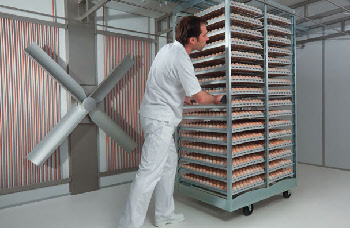



Starting Single-Stage Incubation
Advice on hatchery management changes when starting single-stage incubation from Henry Arts of Pas Reform.Management in a multi-stage hatchery is based on a daily routine of setting eggs according to a strict setting schedule per setter type. The common principle for establishing a setting schedule in a multi-stage incubator is based on the need to transfer metabolic heat from more developed embryos to the less developed, heat-demanding embryos in the early stage of embryonic development.
Embryo temperature in a multi-stage incubator is mainly controlled by the pattern of alternating ‘old’ heat-producing embryos and ‘young’ heat-demanding embryos. The incubators are filled according to the direction of the airflow in that specific make or model of incubator. In addition, the temperature controller is fixed at a specific set point. Embryo temperature is thus only supported approximately in multi-stage incubators.
Management in the multi-stage hatchery cannot accommodate egg quality or the needs of the growing embryo. However, it has becoming increasingly clear that today’s modern breeds need a more accurate approach to incubation to achieve high numbers of good quality chicks that fully realise their genetic potential (Fairchild et al, 2007). Furthermore, the multi-stage incubator cannot easily be cleaned – because it is never empty.
For these reasons, more and more hatcheries are making the transition from multi-stage to single-stage incubation management.
Single-stage incubation runs specific incubation programmes such that the climate in the incubator is programmed to match the specific needs of the developing embryos. Single-stage incubators can also be cleaned after each incubation cycle and thus meet high hygienic standards of today’s food production industry.
Often, the transition from multi-stage to single-stage incubation is initiated by the replacement of aged multi-stage incubators by new single-stage equipment, without an awareness that hatchery management too will need to be adjusted. Management in a single-stage hatchery is certainly not based on a routine, but rather adjusted to accommodate the needs of a specific egg type. Consequently, hatchery managers need to learn about variation in needs of embryos from different egg types, as defined by strain, flock age and the duration of storage.

Advice
- Plan size of setters in accordance with size of batches of eggs. A batch of eggs is the total number of eggs produced on a specific day by one flock in one farm
- Create an overview of the egg types incubated in your hatchery
- Do not mix different batches of egg types. If separating egg types for incubation is not possible:
- Fill setters with batches of eggs that have similar characteristics with respect to strain, flock age and days of storage.
- Avoid filling one incubator with eggs from flocks more than five weeks apart in flock age.
- Avoid filling one incubator with eggs from one flock but with more than five days’ storage difference.
- If the incubator has to be filled with more than one batch of eggs, do not combine fresh eggs with eggs stored for more than five days.
- Follow manufacturer’s guidelines carefully when starting the first incubation cycle in the single-stage incubator.
- Keep records for each incubation cycle, per egg type used and showing the different management steps taken per type.
- Use data with respect to hatchability, incubation time and chick quality from recording forms to fine-tune your incubation programmes.
- Train hatchery personnel so that they are fully advised regarding the different management steps required when using single-stage practices.
- Highlight the need for change: make sure hatchery personnel understand that single-stage management requires a different approach to multi-stage management to succeed.
December 2011








